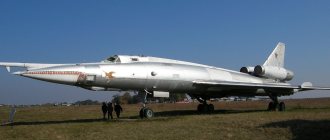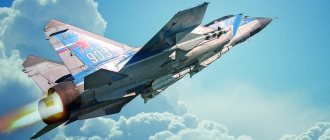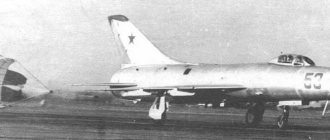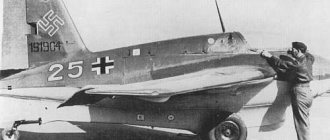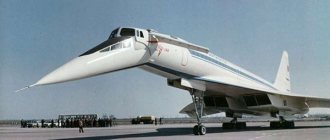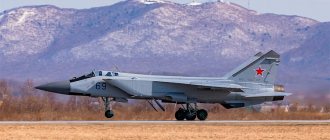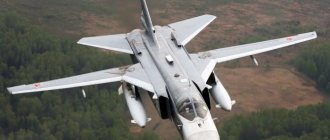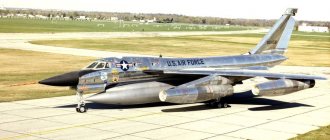The history of the creation of the MiG-31 interceptor fighter
The MiG-31 fighter-interceptor is a further development of the MiG-25P fighter-interceptor. It is intended for use in the country's air defense system, capable of carrying out long-term patrols and combating all classes of air targets (including small cruise missiles, helicopters, high-altitude high-speed aircraft and even (!) space satellites in low orbits) at any time of the day, in difficult weather conditions, when the enemy uses maneuver and sets up active and passive radar jamming and heat traps.
In 1972, the A.I. Mikoyan Design Bureau began work on an improved version of the MiG-25 fighter. Initially, the car was even called MiG-25MP. Like the MiG-25, it was an all-welded aircraft made from special alloys. The general management of development and testing was headed by General Designer R.A. Belyakov. The new aircraft is designed to combat both high-altitude and low-flying targets that have a reduced effective dispersion surface.
Unlike the prototype, the crew of the new fighter-interceptor consisted of two people; the radio-electronic equipment included a radio sight, originally developed for the long-range interceptor with variable wing geometry Tu-148, which was supposed to replace the Tu-128 aircraft.
In August 1975, a crew was assigned to the prototype MiG-31 - test pilot, chief pilot of the MiG company, Hero of the Soviet Union Alexander Vasilyevich Fedotov, leading engineer S.G. Polyakov, mechanic V.N. Kichev. On September 16, 1975, Fedotov took the car into the air for the first time, and comprehensive flight tests began, which lasted for 4 years.
MiG-31 interceptor fighter on takeoff. The characteristic dual landing gear wheels allow the heavy aircraft to take off even from airfields that do not have a good runway surface.
The test pilot himself (and Alexander Vasilyevich spent 5,000 hours in the air, performed 8,998 flights and set 18 world records!) gave the new aircraft the following assessment: “The MiG-31 has the greatest capabilities of all the aircraft that I have ever tested!” Looking ahead, it is worth noting that it was this unique aircraft that ended the life of the honored pilot. On April 4, 1984, during a test flight, an emergency situation arose, as a result of which pilot A. Fedotov and navigator V. Zaitsev died.
However, when the MiG-31 was finally put into mass production in 1979, there was absolutely no reason for sadness. In 1980, the MiG-31 began to arrive in air units, and a year later state tests of the aircraft were completed. With the adoption of this fighter, the USSR, and then Russia, received a powerful “watchdog” of air borders. Capable of destroying any targets not only close to the ground, but also reaching the upper reaches of the planet’s stratosphere, the MiG-31 is truly a unique combat vehicle.
In terms of combat capabilities, the MiG-31, even as of 2015, has no analogues abroad (and even in Russia). A special feature of the MiG-31 is “team” work. Although the aircraft is effective alone, the MiG-31's full potential is truly revealed when operating in groups of four. In this case, the exchange of information between aircraft and the ground-based automatic control system is carried out automatically, and all tasks related to searching for targets and coordinating the group are solved by on-board means that constantly receive information from the ground and interact in the group of interceptors. However, it can operate without the help of the ground, exercising control over a vast protected area with a frontal length of 900-1100 kilometers.
As for a single aircraft, it is capable of simultaneously intercepting several objects flying at different altitudes, on different courses and at different speeds. Although the MiG-31 is a heavy interceptor fighter and is not designed for maneuverable combat, it is nevertheless capable of performing all aerobatics.
In total, from 1979 to 1994, more than 500 interceptors were built, of which about 250 are currently in service with the Russian Air Force. The Kazakh Air Force also has several dozen MiG-31s; another 24 aircraft were delivered to China in the early 1990s (according to some sources).
MiG-31 interceptor fighter
Currently, about 100 MiG-31s have been modernized and completely re-equipped in accordance with modern air defense system requirements, the rest are planned to be written off due to wear and tear. At the same time, in the near future it is possible to re-launch one of the latest modifications of the aircraft into mass production to replenish the aircraft fleet.
Aircraft capabilities
The main threat to the world comes from NATO carrier strike groups carrying American Tomahawk cruise missiles to the shores of any region of the planet. These low-flying targets (2 m - 5 m above the surface of the sea and land) are inaccessible to the anti-missile defense system, but they are within the capabilities of the MiG-31BM, equipped with equipment with visibility in the upper and lower hemisphere. Having become all-seeing and multifunctional, the interceptor tenaciously keeps 24 objects on its radars. Carrying countless weapons (air-to-air, air-to-sea, air-to-ground missiles) weighing up to 9 tons, the aircraft is ready to hit up to 6 of them simultaneously. The fighter intercepts hypersonic targets up to Mach 6.
Good interaction with air defense (air defense) anti-aircraft missile systems is another important advantage of this interceptor. In addition to fighting objects on the ground, on the water and in the air, the Mig-31BM can become a coordination command post (CCP) for the rest of the group’s aircraft with low-power radars.
The current capabilities of our MiG are the guidance of missiles fired from other fighters, which, in radio silence mode, have approached within missile launch range. As a result, the group's work becomes more effective. It is important to note once again that only the MiG-31 is capable of defeating low-flying Tomahawk or ALCM missiles, invisible on long-range air defense radars, and on the first try. It was these missiles from overseas maniacs from the Pentagon that destroyed life in Iraq and Libya; these countries did not have Russian interceptors in their weapons.
MiG-31 interceptor fighter - differences from the MiG-25
Externally, the MiG-31 is very similar to its ancestor, the “twenty-fifth” - two fins, two sloping air intakes on the sides of the fuselage. But then the differences begin, and quite significant ones at that. First of all, it is striking that the MiG-31 has a second cockpit behind the pilot’s cockpit, while the “twenty-fifth” was single-seat. The operation of an aircraft with a fairly impressive take-off weight at conventional airfields forced a change in the design of the landing gear: for the first time, two-wheeled bogies were used on a fighter aircraft, on which the wheels were located in a so-called “spaced tandem”, which reduced the pressure on the runway surface.
The power supply of the aircraft was increased due to the installation of two modified, highly efficient, turbojet, bypass D-30 engines, developing a thrust of 15,500 kg at full afterburner - almost a third more than on the “twenty-fifth”. Unlike other interceptors, the MiG-31 is capable of being refueled several times in flight from flying tankers, significantly increasing the range and flight time.
Predecessor of the MiG-31, MiG-25. It’s quite easy to confuse them externally if you don’t know about the peculiarities of the chassis (as discussed above) and the single-seat cabin of the MiG-25, versus the double cabin of the MiG-31
The new fighter was equipped with an anti-jamming system that ensures reliable interception of air targets. It consists of an airborne radar station with a phased array antenna (used on an aircraft for the first time in the world), a heat direction finder for the forward hemisphere and a tactical situation indicator. Since it became more difficult for the pilot to simultaneously control the vehicle, weapons and sighting and navigation equipment, a navigator-operator was added to the crew.
The MiG-31 also has data transmission equipment designed for interaction between groups of four aircraft in flight in formation, target distribution and coordination of attacks. It allows you to simultaneously track up to ten targets and launch guided missiles at four at once.
As is known, the combat effectiveness of an aircraft depends on the composition and capabilities of its weapons. On the MiG-31 it is selected depending on the characteristics of the target and the combat situation. It may include four long-range missiles with radio homing heads; they are also two medium-range missiles with thermal homing heads; four long-range missiles and the same number of short-range missiles (close maneuver missiles).
It is noteworthy that the designers placed them so that they provide half as much resistance to the oncoming air flow as that of the MiG-25. In addition, a 23-mm cannon with 260 rounds of ammunition is built into the center section of the MiG-31.
What's new in the BM modification
In the early 2000s, the MiG management approached the new government apparatus with a proposal to continue work on modernizing the MiG-31 and received a positive response. It is important that the military department decided to maintain the purpose of the main combat missions, and the interceptor did not become another version of a multirole fighter. There was a demand from the Aerospace Forces to improve the characteristics of its predecessor in intercepting targets, as well as to ensure the ability to qualitatively modernize a large fleet of aging vehicles with on-board electronics, software and weapons.
Many enterprises and scientific institutes got involved in the work, some of them are widely known in the country - these are the Vympel Design Bureau, the Chkalov GLITs, the Tikhomirov Research Institute of Instrumentation, and the Sokol plant. The instrument makers were pleased with the development of the Zaslon-AM weapon control system (WCS), working with the modernized RP-31AM radar, and the unique calculating rig computer, with special software (software). These capabilities of the new Zaslon make it possible to find stealthy targets with an EPR of 3 m2 (4th generation fighters) at a distance of 320 km and hit them at 280 km.
Russian satellite navigation GLONASS installed. The probability of hitting hypersonic targets and cruise missiles has doubled. The aircraft became 1.5 to 4 times more effective in combat. Its radars show 5th generation stealth aircraft before entering close combat, which will make F-22 pilots think about their impunity. The first display of the MiG-31BM took place in 2007 at the MAKS exhibition. After the interceptors were finalized, two aircraft were already seen in 2008; while flying over the military airfield in Savaslake, the pilots of the 3958th Kerch Guards Red Banner Aviation Regiment gave them a good description. The interior of the cabin was preserved to the maximum, only a monitor was added.
Since 2006, Mikoyan Design Bureau has had a long-term contract with the Russian Ministry of Defense. Production of serial aircraft has been ongoing since 2009. Until 2016, the project was being finalized and production was limited. By 2020, at least 60 more MiG-31 winged aircraft will be added, updated to the BM modification.
Read Su-25SM3 attack aircraft - modern strengthening of the ground armed forces
Characteristics of the MiG-31 (NATO: Foxhound)
A country:USSRType:Interceptor fighterYear of issue:1979Crew:2 peopleEngine:2x TRDDF D-30F6 (power 9500 kgf each, or 15500 kgf with afterburner)Maximum speed:up to 3000 km/h (at high altitude), up to 1500 km/h (at low altitude)Practical ceiling:up to 30 kmRange of flight:with 2 PTB: up to 3000 km, with one in-flight refueling: up to 5400 km (combat radius 720 km).Empty weight:21.8 t (empty), 39.1 t (normal take-off)Maximum take-off weight:46.75 tWingspan:13.46 mLength:22.69 mHeight:6.15 mWing area:61.60 sq. m. Weapons:
- 1x 23mm cannon GSh-6-23M (260 rounds)
- 4 long-range guided missiles R-33
- 2x medium-range guided missiles R-40T
- 4 short-range guided missiles R-60.
Characteristics are given through fractions: for the MiG-31 of the first modifications
Equipment
An important part of the weaponry is the Zaslon-M radar station. The 4th generation fighter is detected at a distance of 320 km, it is possible to accompany this target at a striking distance of 280 km with missiles with the K-37M inertial guidance system (the Russian version of the R-37M at exhibitions is RVV-BD, produced since 2014 for the MiG-31BM), There are also R-33S and R-77 in service, reaching the enemy at 120 km. Tests have been carried out confirming these characteristics, which are superior to analogues in foreign countries. In comparison, it is worth noting that the best US interceptor, the F-14D Tomcat, is capable of spotting and hitting an enemy fighter with an ESR of 3 m2 at a distance of up to 160 km (in 2006 it was replaced by the still undeveloped F/A-18E/F Super Hornet, inferior predecessor).
Design of the MiG-31 interceptor fighter
The MiG-31 interceptor fighter is designed according to a normal aerodynamic design with a high-mounted trapezoidal wing and a swept tail with two fins, in general terms repeating the design of the prototype - the MiG-25 fighter. The layout of the MiG-31 is also close to the layout of the MiG-25 aircraft, however, compared to the MiG-25, the proportion of stainless steel parts in the MiG-31 design is reduced. The airframe of the aircraft is made of 50% steel, 16% titanium, 33% aluminum alloys, 1% of the structure is made of other materials.
The fuselage of the fighter is a welded monocoque structure with 57 frames and frames. 15 frames are power frames. The technological division of the fuselage is similar to that of the MiG-25 aircraft.
The forward part of the fuselage is made of aluminum alloys and includes an electronic equipment compartment, a cockpit and a behind-the-cockpit equipment compartment; A radio-transparent radar radome is attached to the front of the nose.
The crew members are located in tandem, with the pilot in the front cabin and the navigator-operator in the rear cabin. Both cabins are pressurized and are equipped with K-36DM ejection seats. The cockpit canopies have movable segments that open upwards and backwards; a retractable periscope for viewing the front hemisphere is installed in the rear cockpit, designed to improve visibility from the navigator's seat during takeoff and landing. The cabins are separated from each other by a transparent sealed plexiglass partition 10 mm thick.
Drawing of the MiG-31 interceptor fighter
Starting with the MiG-31M, the glazing of the cockpit canopies has been changed. The glazing of the side surfaces of the canopy is made of heat-resistant plexiglass 10 mm thick; the material of the canopy canopy is 36 mm thick triplex with an electrically conductive anti-icing layer. Under the cabin there are compartments for placing PrNK units, radio communication equipment and electrical system units.
Welded middle part of the fuselage, like on the MiG-25. is the main power element of the airframe, absorbing most of the loads. There are seven fuel tanks in the middle part of the fuselage. The garrot, located on top of the middle part of the fuselage, covers the wiring (cables and rigid rods) of the mechanical control system.
The air intakes with sharp edges at the inlet have a rectangular cross-section, the inlet channels begin on the sides of the fuselage from frame 2 and continue to frame 6. The amount of air supplied to the engines is regulated by the lower flaps and the upper horizontal wedge automatically depending on the altitude and flight speed.
The vertical and horizontal tail surfaces, a container for two cruciform braking parachutes with a total area of 50 m2, and engine afterburners are attached to the tail section. In the tail section, three thermally insulated compartments house some units of the fuel, hydraulic and control systems.
The wing is trapezoidal in plan with sagging in the root part. The wing sweep angle along the leading edge is 41 degrees, the inflow sweep is 70 degrees. The wing mechanization consists of slotted flaps, ailerons and four-section deflectable leading edges. Aileron deflection angles +/-20 degrees, flap deflection angle - 30 degrees, tip deflection angle - 13 degrees. The power structure of the wing consists of three spars, ribs and stringers. The wing consoles are attached to the fuselage at six points each. There are pylon suspension points on the lower surface of the planes; it is possible to install two pylons under each plane.
The tail consists of two vertical fins installed with camber outward at an angle of 8 degrees to the plane of symmetry of the aircraft, an all-moving stabilizer and two ventral aerodynamic ridges (camber angle 12 degrees). The fins with rudders are identical in design to each other, but differ in the location of the radio-transparent antenna radomes. Each fin is attached to the rear fuselage at three points.
The chassis is tricycle, retractable hydraulically. The nose two-wheeled support is retracted back in flight; A mud guard is installed on the wheels of the front pillar, which reduces the likelihood of foreign objects getting into the air intake when taxiing. The main supports are equipped with two-wheeled trolleys, the wheels of the trolleys are installed one after the other with an offset relative to the longitudinal axis of the trolley; the rear wheel is shifted outward relative to the front. The main supports are retracted against the flight. The front doors of the niches of the main supports are also air brakes. All wheels are equipped with brakes. Chassis track - 3.64 m, chassis base - 7.11 m.
The power plant includes two two-circuit turbojet engines with afterburners D-Z0F-6 developed by the Perm NPO Aviadvigatel, the thrust of each engine is 9500 kgf, in afterburner - 15500 kgf, in takeoff mode - 19000 kgf; bypass ratio is 3, dry weight is 2416 kg. The afterburner is equipped with rings that ensure combustion stability; the supersonic nozzle has special plate valves in the expanding part for air intake and elimination of pressure pulsations in the exhaust gas stream.
Armament complex of the MiG-31 interceptor. Impressive, isn't it?
The fuel is placed in seven fuselage tanks, four wing tanks and two keel tanks with a total capacity of 18,300 liters. There is provision for suspension of two external tanks with a capacity of 2500 liters on external underwing pylons.
The aircraft's on-board equipment includes a sighting and navigation system, including a phased array radar RP-31 N007 "Zaslon", an on-board computer "Argon-K", an 8TP heat direction finder, a KN-21 navigation system with two IS-1-72A inertial systems and a digital computer "Maneuver", a short-range radio navigation system A-312 "Radikal-NP", a long-range radio navigation system A-723 "Kvitok-2" and ultra-long-range navigation radio systems "Tropic" and "Route".
The AK-RLDN digital noise-resistant radio channel provides two-way exchange of tactical information with the ground command post. digital noise-proof equipment APD-518 allows you to exchange data on the air situation at a distance of up to 200 km with aircraft that have interface devices with APD-518 equipment (MiG-31, Su-27 , MiG-29, A-50). The presence of a powerful radar and closed channels for transmitting information in real time allows the MiG-31 to be used as an AWACS and control aircraft.
The on-board electronic equipment also includes a VHF radio station R-862 and a HF radio station R-864. recording device RIU, flight data recorder "Tester-UZL", voice informant P-591, interrogator and transponder of the state identification system, air traffic control receiver TAK-69, automatic radio compass ARK-15, marker radio receiver MRP-66, radio altimeter RV-15, recorder of conversations in the MC-61 flight deck. The onboard defense complex includes the SPO-15SL radar warning receiver and electromagnetic and infrared jamming equipment.
The control system is mechanical with irreversible hydraulic boosters: the SAU-155M automatic control system is installed. The controls are dual, the main controls and a retractable control stick are installed in the navigator's cabin.
MiG-31 on takeoff, rear view
Operation and combat use
The first 31 MiGs began to arrive in the air defense forces in 1980. They were sent to aviation regiments based in Pravdinsk (Kaliningrad region) and to the Air Defense Center in Savasleika (Nizhny Novgorod region). In the future, they had to defend the borders of the USSR in the Far East. A dangerous situation has developed there due to provocative flights of American reconnaissance aircraft near the borders of the USSR. These planes had speeds that exceeded the speed of fighters of that time. After the appearance of Mig-31 fighters in the skies of the Far East, provocative flights stopped.
Currently, 247 Mig-31 aircraft of various modifications are in service with the Russian army and navy. The geography of their deployment is concentrated in the center of Russia (Tver and Vladimir regions), in the North (Monchegosk), in the Urals region (Perm), Eastern Siberia (Krasnoyarsk Territory), in the Far East (Vladivostok, Petropavlovsk-Kamchatsky). The Republic of Kazakhstan has 32 MiG-31s in service.
In 1999-2000, the 31st MiGs took part in the second Chechen war, controlling the airspace over the republic.
Mig-31 in Syria : In November 2016, the Mig-31 was assigned the responsibility of covering the Khmeimim base, the main base of Russian aerospace forces in Syria.

